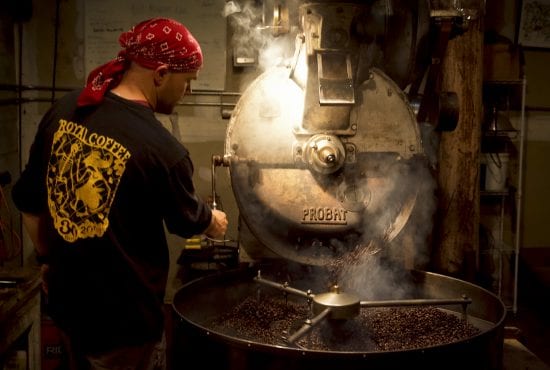
Although the city of Santa Fe, N.M., is small, its art scene brings creatives and foodies alike. We talk to the owners of Ohori’s Coffee—fixtures in the Santa Fe food scene.
STORY AND PHOTOS BY PAUL ROSS
SPECIAL TO BARISTA MAGAZINE
Santa Fe, N.M. (aka “the City Different”), has a population of fewer than 67,000 people. But, being America’s third-largest art city, it’s also a foodie town—so coffee is important. Ohori’s Coffee has been in business for more than 30 years and recently opened a third store. How do owners Tai Ayers and business and life partner Sam Brinegar maintain and grow a successful business (while raising a family)? We talked to them to get the story of their life and business.
Paul Ross: First of all, tell me about the name.
Tai Ayers: Founder Susan Ohori worked at the original Peet’s Coffee in Berkeley. Alfred Peet himself helped her build the first specialty roasting operation in New Mexico in 1984 on the Old Santa Fe Trail. Back then a customer could buy coffee beans or a black cup of coffee—that’s it, no cream. My father was her accountant and bought the business from her (when she wanted to move on). Now I’m the president, store manager, and frequently the barista.
Sam Brinegar: And I’m financial manager and coffee roaster. Before that I was a blacksmith.

PR: Santa Fe is an art and foodie town. How do you fit in?
TA: Coffee and tea are on the outskirts of the foodie movement.
SB: Except when the best chefs in town drink their coffee at Ohori’s.
TA: And we also sell internationally based folk and local art. A coffee roaster is a different business from a café, but businesses like ours combine many things.

PR: Does that include being part of a community?
TA: Caffeine is a drug of communication.
SB: We provide jobs and training. We make donations focused on education, cultural resources, and environment. And we’re a friendly and available place to gather.
TA: Coffee is, if anything, the spirit of human community in a cup.
PR: What would you say are the secrets of success?
TA: Consistency balanced with innovation. Clear and firm decisions. Trusting the heart of one’s business.
SB: Which, in our case, is well-sourced and well-roasted coffee beans.

PR: Isn’t that difficult in today’s ever-changing geopolitical climate?
TA: Yes. But we have valuable and long-time relationships with our suppliers, so we can maintain a selection of over 30 coffees.
SB: And consistency is kept through the uniqueness of an artisan-made product, not controlled by computers or robotics.

PR: How do you manage consistent quality in three stores?
TA: I move all the employees around and have them do everything for our customers; we don’t station our staff. We give people a lot of responsibility and trust so that they feel valued, and this gives the stores consistency.
SB: It’s possible because we’re a family-owned business.

PR: How important are baristas to the business?
SB: The baristas are everything and we know it.
TA: I love our baristas.
PR: Where do they come from?
TA: Schools, budding art careers, just moving through town, needing to pay rent, or wanting to talk to people, make latte art …
SB: … or money …
TA: …while they sing, dance, paint, climb, and parent, bike, do yoga, and think about the world.

PR: How do you train people?
TA: Customers help. They share their knowledge and know what an Ohori’s latte should taste like.
PR: And do you ever have to enlighten the customer?
TA: Education is the soul of our company. In a full-service coffee shop like ours, education moves in both directions between customer and barista.
PR: Your customers provide feedback?
SB: Are you kidding? In the age of internet reviews, every day!
TA: I often work as a barista or take time outside my office in our stores to just talk with people. Feedback comes naturally that way.

PR: How important is local advertising, publicity, and the internet?
TA: I advertise with local companies that I feel support our community, but I still feel word of mouth is king in finding new customers.
SB: I agree. The internet is part of people’s lives, but [word of mouth] is still direct interaction.
PR: How do you compete and separate yourself from the big national chains?
TA: We don’t, really. I guess having the owner make you a cappuccino, and then re-pull a second because it’s not just right, is what separates us.
PR: How do you keep up with current trends?
SB: Often trends mean more cost to the consumer and not much more profit. So we move very slowly in that area.
PR: What would you say to someone entering the coffee business?
TA: It’s not easy and the environmental costs of coffee on our planet are a difficult weight to carry. It is also a very saturated and competitive market: Do your research.
SB: Enjoy the sun and the moon rising, because you’ll be working during both!
PR: Here’s the toughie—can you love coffee too much?
TA: I was married to man who hated the smell of coffee. That didn’t last.
PR: So now you’re married to a roaster!
SB: Even our kids smell like coffee; it gets into everything.
 ABOUT THE AUTHOR
ABOUT THE AUTHOR
Paul Ross travels the world with camera, curiosity, and humor. He has cooked with chefs across the globe and written about it. His articles and photos have appeared in Smithsonian, Popular Mechanics, in-flight magazines, major newspapers, and the Fortean Times, among others.


fun read.
Great article. Love their attitude.